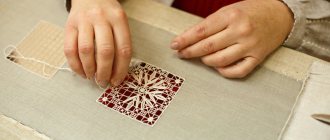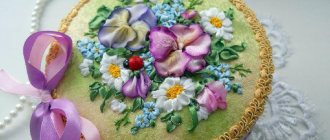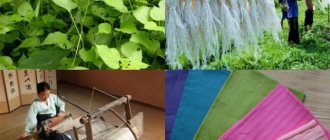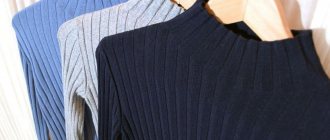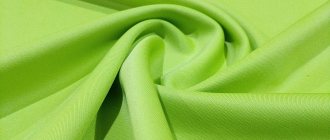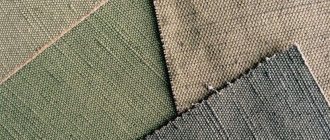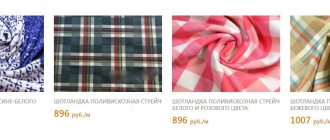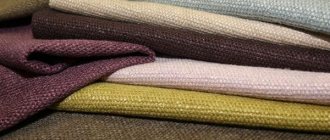DescriptionOrigin
Guipure immediately differs from other fabrics with its airy and delicate appearance due to the elegant combination of fine mesh with intricate lace. The type of lace can be very diverse. The most common options are with a floral or oriental pattern.
Guipure is a thin mesh fabric with convex lace, most often natural or with a small amount of synthetic impurities. This fabric feels soft and pleasant to the touch.
The material can be made from natural, synthetic or mixed fibers. Commonly used cotton, linen, wool, polyester, lycra, viscose and lurex. The threads are woven on special knitting, curtain and knitting machines, using complex leno or openwork weaving.
It is believed that this exquisite canvas first appeared in Ancient Egypt. It came to Europe only in the 16th century, immediately falling in love with local rich ladies who began decorating their outfits with guipure for going out. Initially, the material was made entirely by hand. Many women's dresses of the Renaissance abound in guipure lace with a variety of patterns.
Lace, which is an integral part of this material, can be located throughout the fabric or occupy its upper or lower parts. Thus, products decorated with this decor look very elegant and at the same time gentle, neat and sophisticated.
Advantages and disadvantages
The characteristic features of the fabric, giving it a sophisticated and romantic look, can be attributed to both advantages and disadvantages.
Thin material, which looks very impressive in the finished product, is very difficult to sew and process, and elegant, delicate dresses and skirts require very delicate handling.
Pros:
- spectacular appearance;
- good air exchange;
- ease;
- softness;
- the canvas holds its shape well;
- a variety of guipure fabrics with various laces.
Minuses:
- transparency;
- difficulty in sewing and care;
- tendency to form snags;
- high price.
The color palette of guipure products is usually presented in the most basic shades of white, milky, red, black and gray. Lace is difficult to dye, and the process itself is quite labor-intensive, so there are not too many colors.
Types of guipure products
Most often, guipure fabric is used for things that perform a purely decorative function: tulle, lace gloves, erotic lingerie, and so on.. In more practical clothing, it is used only in combination with various fabrics: reaper, chintz and others.
A base of any fabric gives guipure lace the strength it so lacks. And thanks to the thinness and delicacy of the material, it does not create additional difficulties, easily allowing air to pass through. In addition, an openwork mesh on top of even a plain fabric creates interesting combinations, allowing you to combine completely incompatible qualities in one thing. Also, the base of even the thinnest chintz allows you to keep the fabric from stretching and deformation.
Since the guipure itself has almost no contact with the skin (with the exception of gloves, but they are not intended for long-term wear), the amount of lycra in the composition does not affect human health in any way. However, when purchasing fabric in stores, it is necessary to find out the exact composition, which affects the difficulty of care.
Guipure: very good reviews
So, this fabric is great for a variety of needs. Many fashionistas love to use guipure, leaving positive reviews about it. Women claim that this material consists of individual elements of embossed lace, connected to each other by a thin mesh. But at the same time, its main difference is the presence of synthetic threads here (although not always). Thanks to them, guipure becomes more durable. Reviews only confirm this. Lycra is most often used as such fiber. The entire connecting mesh can consist of it. Lace is made from natural elements.
By the way, it is thanks to these inserts that the fabric is strong and dense. However, from time to time there are other options. In them, lace makes up no more than ten percent of the total area of the fabric. However, it is not very durable and is used exclusively for decorative purposes.
Application
Guipure fabrics are usually used to decorate other light and elegant materials, playing the role of original inserts. In its pure form, such fabric is almost never used because of its transparency. Guipure is used for sewing:
- evening, wedding and other elegant dresses;
- skirts, blouses and tunics;
- underwear;
- gloves;
- collars and cuffs;
- scarves and stoles;
- curtains, drapes and drapes;
- tablecloths and bedspreads.
Most often combined with satin, chintz, chiffon and crepe fabrics. The lace fabric itself can vary significantly in density and some other characteristics. For example, guipure fabrics with viscose in their composition are elastic, and products with lurex have a metallic sheen and shine.
Differences between guipure and lace
Based on their appearance, it is quite difficult to draw a conclusion about these materials - each of them is a fabric consisting of woven patterns interconnected. But, characteristic features still exist.
To make the right choice and fully use the advantages of the fabric, you need to know its properties and be able to independently determine the type and directions of use. So, let's find out how lace differs from guipure. To do this, you should characterize each fabric.
Lace is a material that does not contain a woven base and consists of ornaments formed by weaving threads.
Natural and synthetic fibers are used for its production. The technology for making lace fabric can be manual or machine. Guipure
is a type of lace fabric.
The main difference between guipure and lace
is that in the first case the material has a mesh base and is produced exclusively by mechanization using synthetic threads. In addition, this type of material is highly elastic; tight-fitting clothing models are often sewn from it. Lurex is often added to the composition - a metallized thread, which gives a beautiful shine and rigidity to the fabric. At the same time, lace fabric is softer and more pleasant to the touch. It does not stretch well, so it is suitable for sewing loose-fitting wardrobe items or used for finishing collars and cuffs.
In its structure, a lace product can be thicker than guipure - very thin and almost weightless.
Material properties
You can highlight them, for example, by looking at dresses. Guipure reviews in these cases are very diverse. Since it is quite difficult to highlight the properties here. The fact is that they depend very much on the percentage of smooth and embossed parts, as well as on the amount of lycra in the mesh itself. But still, the main qualities of guipure can be named. Firstly, there is transparency, the degree of which can vary widely. Secondly, it is very light weight, which is important when used in combination with various bases. Thirdly, a certain rigidity, explained by dense lace inserts. This is especially felt when feeling the fabric and trying to bend it in different areas of the design. Fourthly, poor resistance to all kinds of ruptures (with a small number of laces, this is compensated by the base using a header). Well, and finally, poor dyeability due to the use of several types of fiber at once (at least two). Therefore, most often guipure is still monochromatic. Although sometimes there are printed options.
It is also worth considering that when used together with guipure, corrugated fabric sometimes does not behave in the best way. Lace inserts bend very poorly, and this complicates sewing. In addition, restrictions are also imposed on the ironing process.
How to distinguish guipure from lace
Some people consider lace and guipure
absolutely identical fabrics. They make mistakes themselves and mislead others.
Sometimes in magazines there are expressions: “blouse made of lace fabric”, “lace skirt”, “lace dress”.
These descriptions confuse people. It is worth understanding the difference between guipure
from lace.
Guipure dress Both materials are in great demand; they not only have much in common, but also have fundamental differences.
Let's start with the history of the origin of these materials, compare their advantages and disadvantages, find out how they are similar and how they differ from each other. Lace is often used for finishing products. And guipure is a solid fabric from which not only clothes are sewn, but also curtains and other products. History of origin Lace weaving is an art distinguished by its grace and special tenderness. It appeared in France.
Collars and cuffs were decorated with lace.
Not only shawls, but also scarves made from it were in great demand. 16th century lace
with voluminous convex patterns were called guipure. Some historians claim that crocheted lace appeared in the 15th century (France, Spain, Italy). Up to 17th century in Russia they did not practice this type of art. And now clothes made from guipure are distinguished by their elegance and beauty. The fabric is light and perfectly breathable.
Sometimes soft, elastic lining fabric is used in guipure outfits, avoiding contact with the skin. And in our time, guipure
.
Online stores offer a wide range of this fabric. Advantages and disadvantages Guipure does not lose its basic qualities for a long time after numerous washes.
It is virtually wrinkle-resistant, although light ironing may be required. Among the shortcomings, we will name one: if a dense pattern is applied, the fabric turns out to be rough. During wear, puffs may appear on the material.
Therefore, a lining is required when sewing clothes.
The cost of the fabric is quite high. Lace is created using artistic interweaving of threads that form an exquisite pattern. Lace elements are used in the decoration of a variety of things, giving the finished product complete elegance. There are different varieties of lace, differing in the shape of the weave and the principle of production: The main disadvantage of lace
is that it is easy to tear if caught.
And if it doesn’t break when hooked, then perhaps over time the threads in that place will weaken, and it will gradually begin to unravel thread by thread. What is the difference between lace and guipure? Now, you can answer this question yourself.
Indeed, technically and historically related trends in these decorative products are similar, but the differences cannot be ignored. Guipure is a fabric from which you can create a ready-to-use product. Lace is just a finishing element. It is impractical to sew something entirely from lace ribbons, although it is possible and applicable in practice. Doubts are dispelled. Now you will be sure that you are purchasing guipure.
The online store has a wide range of different materials.
Interesting site materials
Successful flower magic and see you again on the VortexFlowers.net website. Don’t hesitate to say “thank you” to your flower master in the comments and show your gratitude by clicking on the social media buttons! Come back often!
Application area
This material is very widely used. It is used for sewing and decoration:
- Evening and everyday dresses (as an addition to the main fabric);
- Skirts and blouses;
- Underwear;
- Outerwear (as decoration);
- Blazers and cardigans;
- Bags and hats (as decoration);
- Curtains, interior items (decorative pillows, bedspreads, tablecloths).
Guipure is amazing. This lace pleasant fabric cannot please anyone with its appearance. Using it as a decorative element on clothes and accessories you can achieve a feeling of celebration and special chic.
© 2021 textiletrend.ru
History of guipure, composition and description of the fabric
Guipure
first appeared in Italy in the 16th century. In Milan and Flanders, when creating it, the “point de rose” technique was used, which involves connecting woven flowers, leaves and plant shoots with tiny piko teeth. As a result, the thinnest relief canvas was obtained.
The history of this fabric in Russia is inextricably linked with the Nizhny Novgorod province. Moscow, Yaroslavl, Tula, Kazan, St. Petersburg and other workshops for its production were also famous.
Each of them had its own production characteristics and typical patterns.
Guipure
differs from
lace
in greater rigidity and density, and today also in the presence of synthetic fibers. In addition to synthetics (Lurex, polyester), thin silk, cotton or viscose threads are used in the production of this openwork material, formed by convex lace elements connected by mesh ligaments.
There are many types of guipure. A description of each of them is presented in the table:
| Classification of guipure | General information | |
| Depending on the type of fibers in the composition | Classical | Lace without additives |
| Knitted | Soft and elastic openwork fabric | |
| Guipure leather | Dense and durable material | |
| Metallic | Thick opaque lace with a metallic sheen | |
| With lurex | Elegant shiny lace | |
| Stretch | Elastic material containing lycra | |
| Reticulate | Fine material with embroidery | |
| By dyeing method | Plain painted | The material is colored after production |
| Printed | A pattern is applied to the finished canvas by hand or using a machine | |
Plainly dyed or printed fabric is, if necessary, decorated with beads, sequins and other decorative elements. You can see what this material looks like in the photo.
